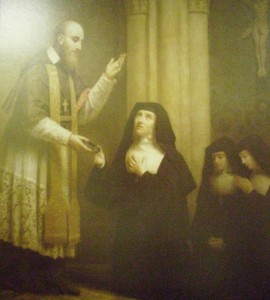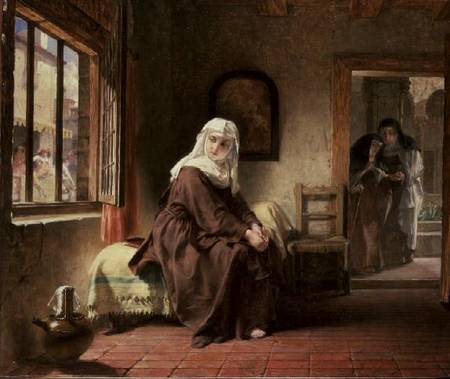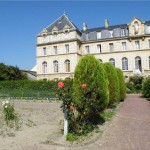
This year we celebrate the 400th anniversary of the foundation of a Visitation Monastery in Paris, France. The jubilee is highlighted at the Museum of the Visitation in Moulins, France with outstanding exhibits.
Here we will share the story of the history of this foundation, with excerpts from E.K. Sanders book “Sainte Chantal”.

“Suggestions for new Foundations reached the Bishop of Geneva from all directions; there began to be a talk of the need of one in Paris, and it was clear that their great venture was fulfilling a high purpose.
In April, 1619,Mother de Chantal came to Paris for the first time. Even the thought of Paris has a magic hold on the sons and daughters of France, and though a Religious of the Visitation had no part in its outward glories, she might be ‘permitted a tremor of delight at the reflection that she was called to a work there which only she had been given power to accomplish. She came there, as she came to Grenoble, with the knowledge that her way had been prepared by Francois de Sales, but in ignorance of the immense difference between the experience that lay immediately before her and any other. It was not, for instance, the persons who were indifferent to religion and of lax or evil conduct who opposed the Foundation in Paris,in the tumultuous general life of the city, its coming or withdrawal would easily have passed unnoticed by such as these ;instead its opponents were to be found in the ranks of the faithful, among whom—as Francois de Sales observed—” the spirit of the world is not altogether unrecognised “.

St Jane de Chantal Arrives in Paris
la Mere de Chantal arrived, and was installed, with two Sisters and two novices who accompanied her, in the house in the Faubourg Saint Marceau. It seems also to have been very unhealthy, and was insufficiently furnished; possibly her whim at the moment was to demonstrate that the Congregation cherished a true love of poverty;the extreme discomfort to which they were exposed cannot otherwise be accounted for. ” Monseigneur tells me,” she wrote, ” that this undertaking is as important as it is possible to be both for the Glory of God and the firm establishment of our Order, and therefore we must further it resolutely through helps and hindrances.”
The real life of the capital,however, had at that period small concern with the practice of devotion, and her horizon would have been dangerously limited but for Celse-Benigne and Francoise, who forced her to realise the existence of the vast multitude of average men and women for whom the atmosphere of Convent parlours had no attraction.
Her difficulties, indeed, were manifold. Open opposition ceased as soon as she arrived, but those who had opposed the coming of the Visitation strove to divert it from its natural course.
A Contemplative Order cannot take over the care of benevolent institutions and retain its own character, but responsibilities of this kind were pressed upon the Visitation in a manner that it was very difficult to resist. La Mere de Chantal was faced with the difficult task of evading the real intentions of influential people with whom it was essential to remain on amicable terms. There were many cross-currents in the religious atmosphere of Paris,and when Francois de Sales had returned to Savoy she had no strong supporter. Vincent de Paul, to whom the spiritual charge of the Community had been entrusted, had not yet won recognition and could not be regarded as a protector, and it was dangerous to place too much reliance on friendly offers of assistance and advice. If there had not been a strong hand on the helm, the Visitation might have been so buffeted and swept about as to lose its true identity, and during the first weeks of life in Paris its progress was not encouraging.
The first move was made early in July, but it was a matter of infinite difficulty to find a site for a permanent house. The Superior was calm in the midst of innumerable difficulties however, and therefore the atmosphere of the Religious Life could be sustained. ” You ask me, my dear daughter,” she wrote in the early autumn, “if we are in poverty; yes, truly we are and I seldom give a thought to it.

The Plague
In September, 1619, there was an outbreak of the plague in Paris. Apart from the danger to the lives of the Sisters it was disastrous to their position. They depended on the friendship and support of those who sought them out and learnt gradually to desire their presence as a permanent institution in the city, The letters of the Superior betray no disturbance. She had been mourning the departure of Francois de Sales, but her regret changed to rejoicing at the thought that he had escaped danger. By Christmas the scare was over, and Paris returned to normal conditions.
Those who had begun to discover the spirit of tbe Visitation were not estranged by a temporary absence, and it grew evident that the danger of the new Foundation would not be from isolation but from over pressure. She told la Mere Favre that the importance of the Paris House surpassed that of any other ; it would be the training-school of the Order in France, and so would need especially a Mother Superior who was gentle and wise,strict in observance and self-repression yet full of enthusiasm.

Already there were many who desired acceptance as novices although it was only nine months since la Mere de Chantal arrived in Paris, and there was still no Monastery suited to be the home of the Congregation. In her letters she asks for prayers that this grave difficulty may be solved.Living was very expensive and the Visitation could only take its fitting place if some of the novices came from wealthy families ; yet these were deterred by the lack of an established house. And no consideration of riches influenced the Superior in acceptance and rejection. the method of dealing with great folk who demanded her presence even when she was in chapel.
Daily Life
” Here—unless it is some great ecclesiastic or a princess they are told that we are at Office and I do not come out,but I do have the message brought to me, so that I may judge what it is best to do in case it is some one of such standing that one dared not keep them waiting. I am telling you this that you and other Superiors may do the same ; until now I have not dared to take this line, I have been so afraid of giving offence ; but our Rule binds me and I say so ; the result is that people are impressed instead of being impatient; and indeed unless we do this we shall be overwhelmed, wasted, and distracted more than we should be in the world.
New Monastery and Departure
The important question of their monastery was at length settled. In October, 1620,she discovered exactly what she wanted and was confident that God had led her to it. The negotiations were long and troublesome, but the house that was finally secured,the Hotel de Petit-Bourbon, Rue des Celestins, was really adapted to their needs. It was a central position and in a quarter where their presence was likely to be valued. They had a circle of real friends, and their spiritual charge was in the hands of Vincent de Paul. At the end of February,1622, she received the formal order from Francois de Sales and left Paris amid many lamentations.

The influence of the Visitation had spread widely in the years since her arrival there. ” I believe that God is blessing us greatly,”she said, ” there seems every likelihood that we shall have Foundations in many of the chief towns. May He give us grace to be founded in righteousness.” It was six months before she was able to transfer the reins of government to la Mere Favre. On October 28,1622, she left Dijon for Lyons, where she was to meet Francois de Sales.
Source: Sainte Chantal- by EK Sanders
CHAPTER X.
THE VISITATION IN PARIS.
1619 to 1622.